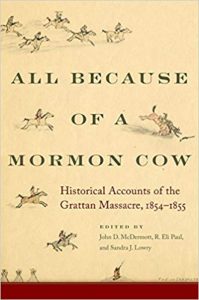 Review
Review
Editors: John D. McDermott, R. Eli Paul, and Sandra J. Lowry
Title: All Because of a Mormon Cow: Historical Accounts of the Grattan Massacre, 1854-1855.
Publisher: University of Oklahoma Press, 2018
Genre: Documentary History; Native American History
Year: 2018
Pages: 222
Binding: Hardback
ISBN-13: 978-0806161532
Price: $29.95 (Amazon, but buy local if you can!)
Reviewed by Greg Seppi for the Association for Mormon Letters
As a pivotal event in the history of conflict between the United States and the Lakota people who lived near Fort Laramie in what was then Nebraska Territory, the 1854 Grattan Massacre has traditionally been examined without serious consideration of the views of the Lakota involved. The event’s significance as the first major event in the First Sioux War and its relationship to the ongoing conflicts between United States military groups and plains-dwelling Native Americans make it a vital episode for study of the American West.
As noted in the book’s preface, the surface-level cast of characters reads like a Western novel—the seemingly incompetent and inexperienced lieutenant who leads his detachment to their doom, the Lakota leaders killed when they attempt to maintain peace between their people and the army, a Mormon emigrant who abandons a cow and makes a claim on it after it is butchered, a translator who dies in tragic fashion, and the “avenging angel” of Colonel Harney who led an attack on a Lakota village at Blue Water Creek in response, and so on (p. xv-xvi). As the preface goes on to note, the stated goal of the book is to broaden this cast of characters to a more realistic and diverse body of witnesses, adding depth to our understanding of the early years of conflict between the American army and the Lakota Sioux.
This book was ably compiled and edited, and it is unfortunate that two of the editors—Sandra J. Lowry and John D. McDermott—passed away before the book was published. Their care for this story and attention to detail are impressive. Documentary histories in this style are invaluable for the multiple perspectives they offer on complicated historical events. Those who experience historical events firsthand are never unbiased in their reporting as they lack the benefits (and hindrances) of hindsight. Nevertheless, witnesses provide those who write about history with the raw material to interpret the past. How history is written depends a great deal upon the sources used to write it.
In this regard, All Because of a Mormon Cow is an important entry into the general literature on conflicts between the United States military and the myriad Native American groups who lived near the trails taken by settlers headed west in the 19th century. Each document included in the volume is prefaced by a short, thoughtful statement providing context and placing it in the wider context of the conflict. In addition to eyewitness reports published in newspapers and testimony from official government documents, sworn statements, portions of letters and journals, and even business reports from fur traders impacted by the Grattan massacre and the Blue Water Creek massacre, provide substantial information for researchers exploring the expansion of the American West and the attendant violence that followed as Americans treated groups like the Lakota Sioux with a complete lack of regard.
While the editorial process used for the volume lacks the substantial body of annotations found in something like the Joseph Smith Papers project, this volume is highly readable. In terms of “Mormon” history, the inclusion of statements by Church leaders regarding the conflict highlights the sympathy Church leaders sometimes showed for those treated badly by the U.S. government, especially Native Americans. One should note, however, that this sympathy rarely extended to groups the Mormon settlers conflicted with as they settled in Utah and surrounding areas.
While I would not recommend this text solely as a piece of “Mormon” history, it provides detailed information about the situation along the trail taken by the pioneers in the 1850s, containing numerous references to Mormon settlers. This book is a key foundational text for the study of conflict between Native American groups in the American West and the United States, and I would highly recommend it to anyone interested in learning more about that topic. Portions of the book would be useful in high school American history courses, and the text could easily serve as an important part of any college course on American history or on how histories are written.
The text is supported by the traditional scholarly apparatus, including a table of contents, an excellent index, and endnotes. Especially in a volume such as this, footnotes would have been much preferable, but the endnotes are nevertheless valuable and provide additional points of research for scholars investigating this or related topics in American history. This book probably deserves to win awards for documentary histories from several organizations; the editors’ care in its assemblage shines throughout the text, and it is a valuable contribution to the history of the American West.
�
